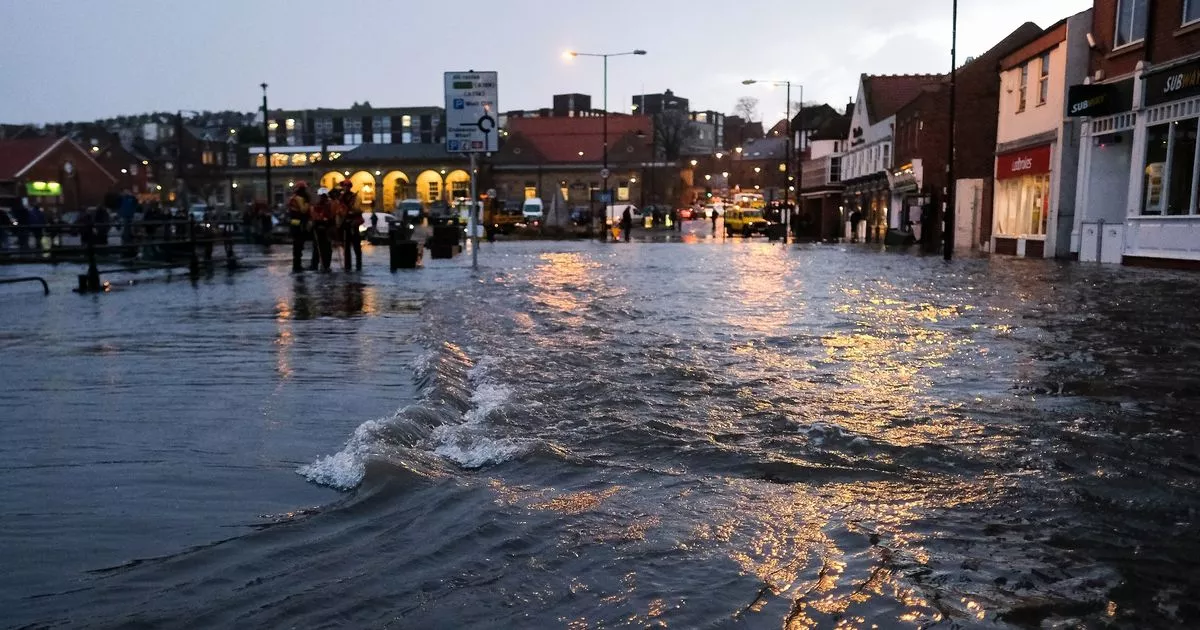Current Flood Warning: Immediate Actions To Take (NWS)

Table of Contents
A current flood warning issued by the National Weather Service (NWS) signifies imminent danger. Rising floodwaters pose significant threats to life and property. Understanding immediate actions is crucial for your safety and the safety of your loved ones. This guide outlines critical steps to take during a flood warning, helping you navigate this emergency effectively.
Understanding the NWS Flood Warning
A flood warning, issued by the NWS, means that flooding is occurring or is imminent. This is a more serious alert than a flood watch (which indicates conditions are favorable for flooding) or a flood advisory (which suggests that minor flooding is occurring or is possible). Different types of floods exist, including flash floods (rapidly rising water) and river floods (slower-rising water from overflowing rivers or streams). Understanding the specific type of flood mentioned in the warning is vital for taking appropriate action.
- How to receive NWS alerts:
- NOAA Weather Radio: A dedicated weather radio provides continuous updates, even during power outages.
- Weather Apps: Numerous weather apps (like the NWS app) offer real-time alerts and warnings directly to your smartphone.
- Local News: Stay informed through local news channels, websites, and television broadcasts.
- Understanding the severity level: The NWS warning will specify the severity of the flooding. Pay close attention to descriptions like "minor," "moderate," or "major" flooding to gauge the potential impact.
- Identifying affected areas: The warning will clearly define the specific geographic areas under threat. Check if your location is included in the affected zones.
Immediate Actions to Protect Your Life and Family
Your safety is the paramount concern during a flood warning. If authorities issue an evacuation order, obey it immediately. Evacuation is the most effective way to protect yourself from the dangers of rising floodwaters.
Moving to higher ground is crucial if evacuation is not immediately possible or feasible. This might involve moving to the upper floors of your building or seeking refuge in a designated shelter.
- Gather essential items: Collect vital documents (insurance policies, identification), medications, and other essential items. Pack these in waterproof bags if possible.
- Secure pets and livestock: Ensure your pets and livestock are safe. Bring them indoors or to higher ground. If evacuation is necessary, take them with you.
- Turn off utilities: Turn off gas, electricity, and water to prevent further hazards.
- Move valuable items: Relocate furniture, electronics, and other valuable items to higher floors or safer locations.
Protecting Your Property During a Flood
While saving lives is the priority, minimizing flood damage to your property is also important. Flood insurance is highly recommended as a preventative measure against financial losses. Being prepared beforehand can significantly reduce the extent of damage.
- Move furniture and appliances: Move furniture and appliances to higher levels to prevent water damage.
- Sandbagging (if time allows): If you have time, sandbag doors and windows to prevent water from entering your home.
- Protect electronics and valuables: Use waterproof containers or bags to protect sensitive electronics and irreplaceable items.
- Park your vehicle safely: Move your vehicle to higher ground away from flood-prone areas.
Staying Safe During and After the Flood
Floodwaters are extremely dangerous. They are often contaminated with sewage and debris, posing serious health risks. After the floodwaters recede, the dangers don't completely disappear.
- Avoid floodwaters: Never drive or walk through floodwaters. The depth and current might be deceptively strong.
- Beware of downed power lines: Stay away from downed power lines, as they are electrically charged and extremely hazardous.
- Avoid damaged buildings: Damaged buildings are unstable and pose a significant risk of collapse.
- Report damage: Report any damage to your property or infrastructure to local authorities.
- Safe cleanup: When cleaning up after a flood, wear protective gear and dispose of flood-damaged materials appropriately.
Conclusion
Responding effectively to a current flood warning from the NWS is vital for survival and property protection. Taking swift action to evacuate, secure your home, and stay informed significantly reduces risk. Remember, safety is the top priority. Stay informed about current flood warnings issued by the National Weather Service (NWS) and take immediate action to protect yourself and your loved ones. Check your local NWS website regularly for updates and follow all official instructions. Don't delay—your safety depends on it!

Featured Posts
-
 Wildfires Intensify Global Forest Loss Hits Unprecedented Levels
May 25, 2025
Wildfires Intensify Global Forest Loss Hits Unprecedented Levels
May 25, 2025 -
 New Music Joy Crookes Drops I Know You D Kill
May 25, 2025
New Music Joy Crookes Drops I Know You D Kill
May 25, 2025 -
 Annual General Meeting 2025 Philips Announces Agenda Updates
May 25, 2025
Annual General Meeting 2025 Philips Announces Agenda Updates
May 25, 2025 -
 Republican Deal Trumps Muscle Flexing Tactics
May 25, 2025
Republican Deal Trumps Muscle Flexing Tactics
May 25, 2025 -
 Naomi Kempbell 55 Let Luchshie Foto Supermodeli
May 25, 2025
Naomi Kempbell 55 Let Luchshie Foto Supermodeli
May 25, 2025
Latest Posts
-
 Pogacars Unrivaled Performance Secures Tour Of Flanders Triumph
May 26, 2025
Pogacars Unrivaled Performance Secures Tour Of Flanders Triumph
May 26, 2025 -
 Tour Of Flanders 2024 Pogacars Stunning Solo Win
May 26, 2025
Tour Of Flanders 2024 Pogacars Stunning Solo Win
May 26, 2025 -
 Pogacars Tour Of Flanders Solo A Masterclass In Cycling
May 26, 2025
Pogacars Tour Of Flanders Solo A Masterclass In Cycling
May 26, 2025 -
 Pogacars Dominant Solo Victory At The Tour Of Flanders
May 26, 2025
Pogacars Dominant Solo Victory At The Tour Of Flanders
May 26, 2025 -
 Paris Roubaix Results Van Der Poel Third Pogacar Significantly Behind
May 26, 2025
Paris Roubaix Results Van Der Poel Third Pogacar Significantly Behind
May 26, 2025
